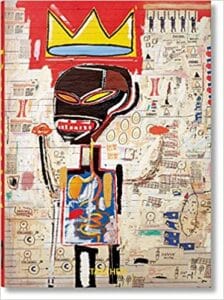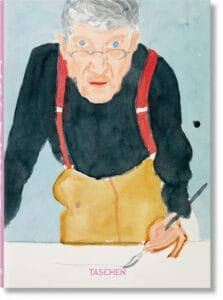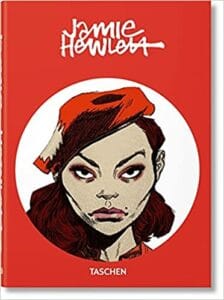Ai Weiwei. 40th Ed.
R450This monograph explores each of Ai’s career phases up until his release from Chinese custody. It features extensive visual material to trace Ai’s development from his early New York days right through to his recent practice.
Showing 1–16 of 35 results

This monograph explores each of Ai’s career phases up until his release from Chinese custody. It features extensive visual material to trace Ai’s development from his early New York days right through to his recent practice.

“For the person who gets a kick out of movies such as Shrek 2 and Finding Nemo, consider Animation Now!, a survey of 80 of the great cartoonists and animation studios worldwide, from Hollywood’s Pixar, Walt Disney, and DreamWorks SKG, to decidedly higher-brow practitioners such as South African artist William Kentridge.” – Business Week, New York

This fresh TASCHEN edition considers Art Nouveau as a broad historical phenomenon with distinct local features.

Basquiat’s expressive style was based on raw figures and integrated words and phrases. His work is inspired by a pantheon of luminaries from jazz, boxing, and basketball, with references to arcane history and the politics of street life?so when asked about his subject matter, Basquiat answered “royalty, heroism and the streets.”

For Marc Chagall (1887-1985), painting was an intricate tapestry of dreams, tales, and traditions. His instantly recognizable visual language carved out a unique early 20th-century niche, often identified as one of the earliest expressions of psychic experience.
 Out of stock
Out of stockThis book brings together a selection of colorful propaganda artworks and cultural artifacts from Max Gottschalk’s vast collection of Chinese propaganda posters, many of which are now extremely rare.

Pop artist, painter of modern life, landscape painter, master of color, explorer of image and perception?for six decades, David Hockney has been known as an artist who always finds new ways of exploring the world and its representational possibilities.

After Egon Schiele (1890–1918) freed himself from the shadow of his mentor and role model Gustav Klimt, he had just ten years to inscribe his signature style into the annals of modernity before the Spanish flu claimed his life. Being a child prodigy quite aware of his own genius and a passionate provocateur, this didn’t prove to be too big a challenge.
His haggard, overstretched figures, extreme depiction of sexuality and self-portraits, in which he staged himself with emaciated facial expressions bordering between brilliance and madness, had none of the decorative quality of Klimt’s hymns of love, sexuality and yearning devotion. Instead, Schiele’s work spoke of a brutal honesty, one that would upset and irreversibly change Viennese society.
 Out of stock
Out of stockWith investigations into everything from black holes to exoplanets, the Hubble Telescope has changed not only the face of astronomy but also our very sense of being in the universe. On the 30th anniversary of its launch into low-earth orbit, this updated edition of Expanding Universe presents 30 brand new images, unveiling more hidden gems from the Hubble’s archives.
Ultra-high resolution and taken with almost no background light, these pictures have answered some of the most compelling questions of time and space while also revealing new mysteries, like the strange “dark energy” that sees the universe expanding at an ever-accelerating rate.

Among the few women artists who have transcended art history, none had a meteoric rise quite like Mexican painter Frida Kahlo (1907–1954). Her unmistakable face, depicted in over fifty extraordinary self-portraits, has been admired by generations; along with hundreds of photographs taken by notable artists such as Manuel and Lola Álvarez Bravo, Nickolas Muray, and Martin Munkácsi, they made Frida Kahlo an iconic image of 20th century art.

With influences ranging from hip hop to zombie slasher movies, Hewlett emerged in the mid-1990s as co-creator of the zeitgeist-defining Tank Girl comic. With then-roommate Damon Albarn, he went on to create the groundbreaking cartoon band Gorillaz. The award-winning virtual pop group of animated characters is a truly global phenomenon. Gorillaz have topped charts around the world, toured the globe from San Diego to Syria, and picked up hundreds of millions of streams and record sales along the way.

This volume lifts the veil on a much-loved but little-understood art form by presenting the most exceptional Japanese woodblock prints in their historical context
 Out of stock
Out of stockLike most of Christo and Jeanne-Claude’s work, L’Arc de Triomphe, Wrapped is temporary and runs for 16 days from Saturday, September 18 to Sunday, October 3, 2021. Carried out in close collaboration with the Centre des Monuments Nationaux, the historic structure is wrapped in recyclable polypropylene fabric in silvery blue and recyclable red rope. The project is the posthumous realisation of a long-held dream for Christo and Jeanne-Claude, who first drew up plans to wrap the Arc de Triomphe in 1961 while renting a small room near the monument.

From the mighty halls of ancient Alexandria to the coffered ceilings of the Morgan Library in New York, human beings have had a long, enraptured relationship with libraries. Like no other concept and like no other space, the collection of knowledge, learning, and imagination offers a sense of infinite possibility. It’s the unrivaled realm of discovery, where every faded manuscript or mighty clothbound tome might reveal a provocative new idea, a far-flung fantasy, an ancient belief, a religious conviction, or a whole new way of being in the world.
 Out of stock
Out of stockThis monograph renders all of Rembrandt’s self-portraits – from his first experimentations at age twenty-two to his final self-portrait painted a year before his death – and stands testament to a life committed to revolutionizing painterly practice both in content and form.

Though often misunderstood, Renoir remains one of history’s most well-loved painters―undoubtedly because his works exude such warmth, tenderness, and good spirit.
No products in the basket.